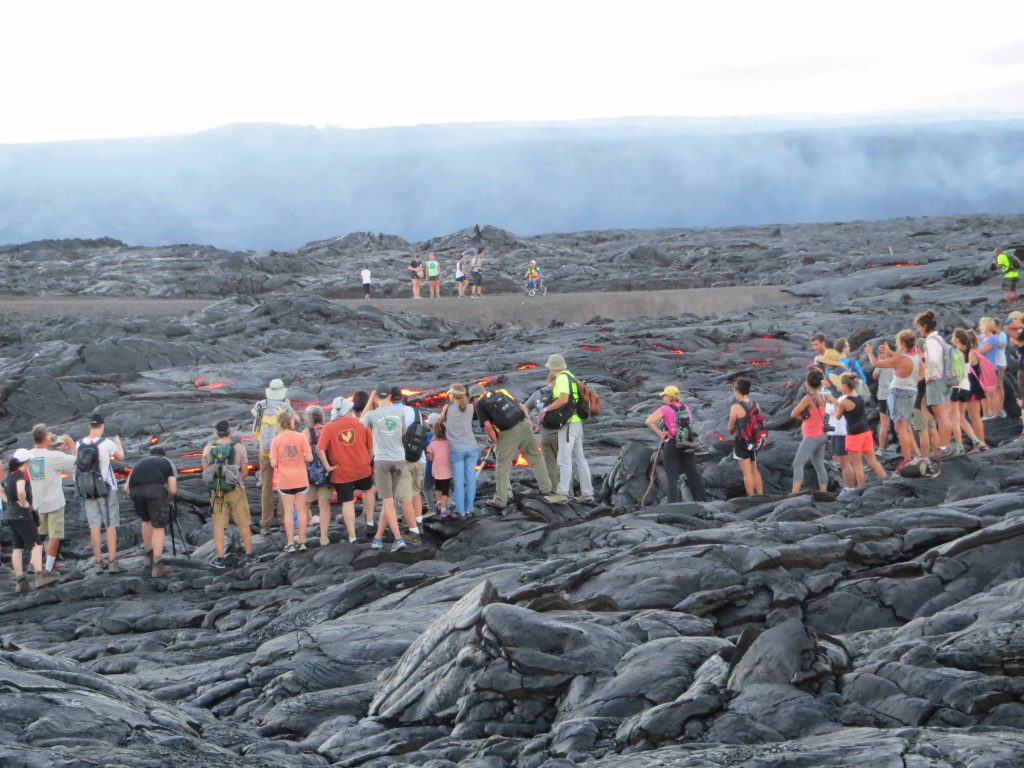What’s Hot and What’s Not in Lava Field Fashion

What’s Hot and Not in Lava Field Fashion: A wide range of clothing and preparedness is seen amongst the estimated 1,500 people a day visiting Kilauea’s active flow field and ocean entry. USGS photo.
An estimated 1,500 visitors a day hike across the lava flow fields to view the ocean entry and search for active lava breakouts. Round-trip walking distance is far; a one-way trip to the ocean entry from Kalapana is around 4 miles. Add the chase for active lava, milling about, and your hike will quickly add up to over 10 miles when you return.
With most visitors to Hawai‘i not packing much real hiking gear, it’s not uncommon to see visitors to the ocean entry that are not dressed for the adventure.
Here are some tips from for essential lava field fashion from the USGS Hawaiian Volcano Observatory geologists who walk miles on Kīlauea lava flows—both new and old.
Fields of newly erupted lava are not flat—they’re hummocks, cracks and crags that have been uplifted and overturned by the pressure of molten lava moving within the flows. To prevent sprains, shoes with support are a must. Boots with high ankle tops are ideal. But, low or mid-top shoes will work with thicker socks. No-show socks or no socks at all are not recommended as they provide fragments of glass a direct path to your skin.
The glass fragments are produced from the thin surface of solidified pahoehoe. It crunches under foot and peels away to form razor sharp flakes. These flakes lie in wait, ready to scrape an ungloved hand if extended to the ground during a stumble or fall. So, if you go walking far distances on the pahoehoe, it’s a good idea to wear light gloves to help catch your fall. Cotton garden gloves work fine. While hiking with these seems silly, one fall without them and you’ll be a believer. Light gloves are standard gear among the scientists and student groups that regularly visit the flow field.
Light cotton clothing is recommended as a base layer, or next to the skin. Long-sleeved shirt and long pants made of natural fiber will not only prevent sunburn, they also offer a measure of protection against scrapes and abrasions. Synthetic clothing, while fast-drying and light, must not be exposed too closely to an active lava flow or it will quickly melt. While this is usually not dangerous, it will ruin the material. Particularly today’s expensive rain gear (which should be in your pack, too).
Most light shoes, not matter how fashionable, will melt if you stand on hot lava. This is obvious. However, what’s not so obvious is what a hot, or freshly-formed, lava flow looks like. Contrary to popular belief, a flow formed minutes ago does not glow an orange-red. Its surface is a dull silver color and the air above it shimmers with heat.
Melting shoes are often not immediately noticed by the wearer. The attention getter is when the soles separate. Stitched soles, common on heavy hiking boots, are ideal as they do not delaminate under heat. But, the more affordable glued soles are fine as long as you watch the ground temperature closely. Don’t wear shoes with steel toes or metal shanks. The metal can heat up to foot-cooking temperatures.
Best practice is to keep safe distances from active lava to protect your skin and those outdoor-gear investments.
All the usual accessories are still in fashion: hat, sunglasses, backpack, etc. Multiple water bottles are recommended. Another overlooked item, the flashlight, is so in vogue that anyone sporting one will be the life of the party as soon as the sun goes down. Since the best viewing is during dawn or dusk (when you can see the glow), an LED flashlight or headlamp is priceless. So, don’t go without one, day or night.
Of course, all this fashion does come with a formality: Remember to stay in designated safe areas despite what you see or read in social media.
Volcano Watch is a weekly article and activity update written by U.S. Geological Survey`s Hawaiian Volcano Observatory scientists and colleagues.
















